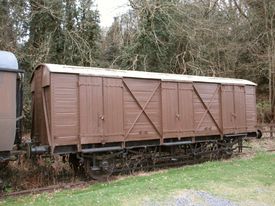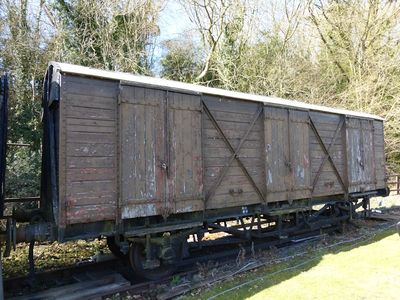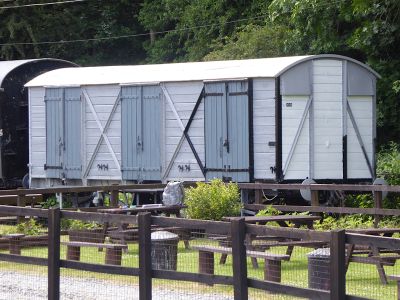GWR 3429 Fruit D Van
| GWR 3429 Fruit D Van | |
|---|---|
 FRUIT D W3429 (2024) | |
| Built By | BR Swindon |
| Status | Static use |
| Number | W3429 |
| Other Numbers | W3429W |
| History | |
| Built | 1950 |
| Designed By | Collett |
| Diagram | Y14 |
| Lot | 1723 |
| Type | 4-w ventilated van |
| Telegraphic code | FRUIT D |
| 1973 | Arrived on SVR |
Contents
Fruit vans
The GWR's first ventilated vans specifically intended to convey fruit dated from 1889. They were given the telegraphic code FRUIT and due to the perishable nature of the goods they carried, they were intended to be used in fast passenger services rather than slow goods trains. As such, they were allocated numbers in the coach series and classed as classed as " Non Passenger Carrying Coaching Stock".[1]
The FRUIT D was the largest and last type of ventilated passenger fruit van designed and built by the GWR. It had an 18ft wheelbase with a length of 28ft 6in over the headstocks and a capacity of 10 tons. Access was provided by three sets of double doors on each side. 50 were built by the GWR between 1939 and 1941 to Diagram Y11.[1] BR continued to build FRUIT Ds to Diagram Y14, with a further 100 including W3429 and W3467 completed between 1950 and 1956.[note 1] All 100 were given vacant numbers in the GWR coach numbering series; as built all would have received a W prefix with an additional W suffix from new or subsequently added as part of the numbering changes following the introduction of BR's Mark 1 coaching stock. A final 115 including W95080 and W92090 were built between 1957 and 1958 to BR's Diagram 105; these received numbers in the BR coach numbering series from new.[2] [note 2]
FRUIT Ds were also used for express parcels when not carrying fruit,[1] and many FRUIT Ds continued in use after main line service as Engineers' Departmental or Internal User vehicles.
Service and preservation
W3429 was built by BR at Swindon in 1950 to diagram Y14, lot 1723.[3] It was gas-lit and piped for steam heat, although not heated itself.[4] It was withdrawn circa March 1973.[2]
The Hinton Manor Fund had brought GWR 7819 Hinton Manor to the SVR in January 1973 for restoration. The fund acquired W3429 in the same year, intending to use it for loco spares storage. It arrived on the SVR from Ipswich on 11 September 1973, carrying a BR blue livery.[5]
Restoration of 7819 was completed in 1977 although the locomotive entering service using cab fittings borrowed from 1501 and a tender borrowed from 3205. Restoration of 7819's own cab fittings and tender was completed over the winter of 1979-80. At that time, W3429 was still owned by the Hinton Manor Fund, although by 1990 it had been moved to Highley for station staff use, with ownership assumed by the Highley Station Fund.[6]
W3429 was repainted in 1997[7] and again in situ during 2021 as shown below. It can be seen on the flat area of land at Highley adjacent to the Signal Box which was formerly the site of a short-lived stone quarry siding in the early 1880s. After its most recent repainting, it has reverted to GWR brown livery, although unlettered, as seen in the main picture above.
See also
Notes
References
- ↑ 1.0 1.1 1.2 Atkins, Beard & Tourret (2013) pp. 441, 448, 453-454.
- ↑ 2.0 2.1 Longworth (2018) p.156
- ↑ Railway Heritage Register Wagon Survey
- ↑ SVR Stock Book Ninth Edition
- ↑ SVR Stock Book Fifth Edition, September 1974
- ↑ SVR Stock Book Eighth Edition, February 1990
- ↑ Railway Heritage Register Wagon Survey

